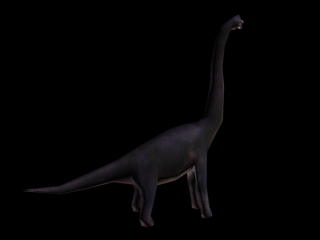|
|
|
"Brachiosaurus"

Brachiosaurus altithorax
(Latin bracchium = "arm" + Greek sauros = "lizard")
Size: 25 meters (82 feet) Period: Late Jurassic (156 million to 145 million years ago) Place: Colorado, Tanzania
Distinguished by a remarkably long neck and supported by a tremendously powerful backbone, the Brachiosaurus is often compared to the giraffe largely due to its asymmetrical body design: the front legs are longer than the back, creating a sloping effect that makes the creature look even bigger than its already gargantuan height. The front feet each feature a single claw, while the hind feet each have three. While perhaps intended as defensive measures - as if a healthy Brachiosaurus needed to worry about predators - the claws have proven to fulfill the more curious purpose of gathering food, as described below.
Environment: Due to its disproportionately large nostrils, it was originally hoped that the Brachiosaurus would reside mainly in the lagoon. Once immersed, however, the substantially higher water pressure at lower depths made breathing impossible. After a few tragic experiments, the decision was made to move the Brachiosaurus to the plains.
Feeding: Plant-eater. While the Brachiosaurus prefers to eat from tree tops, it has surprised everyone with a method of gathering food unique among the other dinosaurs. Using its front legs for support, the creature is able to "harvest" its meals from the grassy plains, tearing the foliage from the soil with its clawed hind legs. Habits: Solitary nature.
Some concern has been expressed over the creature's decidedly low libido. Testing continues.
Ops Notes: Aside from the (relatively) active exercise of gathering food, the Brachiosaurus has proven to be a disappointment in the personality department. It has proven difficult to maintain a healthy population, as many of the creatures have been dying suddenly. Cause of death remains a mystery.
Also common in the Sauropod swamp: Parasaurolophus